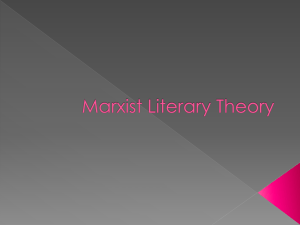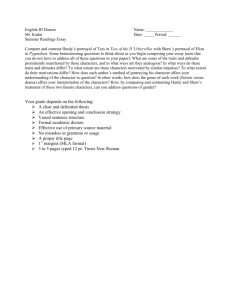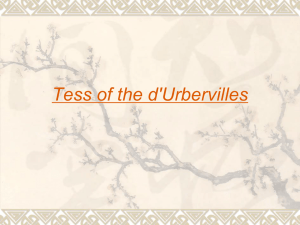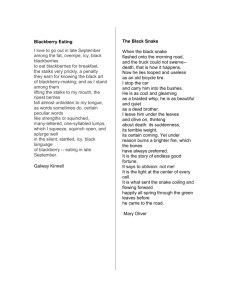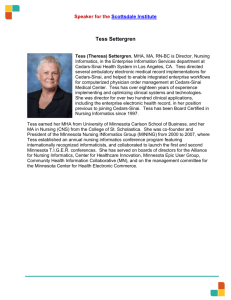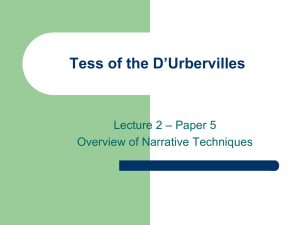Tess
advertisement
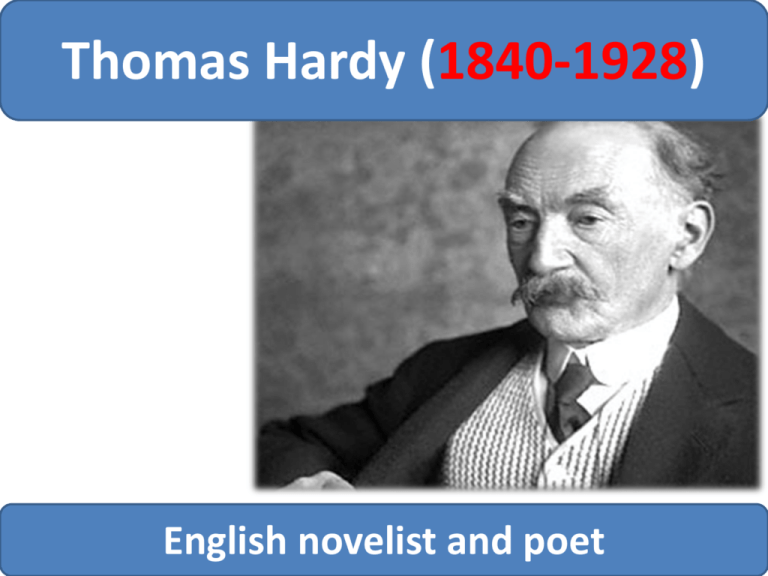
Thomas Hardy (1840-1928) English novelist and poet Family Background • His father Thomas (d.1892) worked as a stonemason and local builder. • His mother Jemima (d.1904) was well-read. She educated Thomas until he went to his first school at Bockhampton at age eight. • a family of Hardy's social position lacked the means for a university education, and his formal education ended at the age of sixteen when he became apprenticed to James Hicks, a local architect.[2] Life as an Architect • Hardy trained as an architect in Dorchester before moving to London in 1862; there he enrolled as a student at King's College, London. He won prizes from the Royal Institute of British Architects and theArchitectural Association. Hardy never felt at home in London. He was acutely conscious of class divisions and his social inferiority. Hardy’s Cottage Literary Career • Hardy's first novel, The Poor Man and the Lady, finished by 1867, failed to find a publisher • Desperate Remedies (1871) and Under the Greenwood Tree (1872) were published anonymously. • In 1873 A Pair of Blue Eyes, a novel drawing on Hardy's courtship of his first wife, was published under his own name. • Far from the Madding Crowd (1874) was successful enough for Hardy to give up architectural work and pursue a literary career. Major Works • Far from the Madding Crowd (1874) • The Return of the Native (1878) • The Mayor of Casterbridge (1886) • The Woodlanders (1887) • Tess of the d'Urbervilles (1891) • Jude the Obscure (1895) Reception • Tess of the d'Urbervilles (1891) attracted criticism for its sympathetic portrayal of a "fallen woman" and was initially refused publication. Its subtitle, A Pure Woman: Faithfully Presented, was intended to raise the eyebrows of the Victorian middle-classes. • Jude the Obscure met with even stronger negative outcries from the Victorian public for its frank treatment of sex, and was often referred to as "Jude the Obscene". Impact on Hardy’s Life • Despite this criticism, Hardy had become a celebrity in English literature by the 1900s, with several highly successful novels behind him, yet he felt disgust at the public reception of two of his greatest works and gave up writing fiction altogether Literary Themes • Hardy critiques certain social constraints that hindered the lives of those living in the 19th century. • Nineteenth-century society enforces these conventions, and societal pressure ensures conformity. • love that crosses the boundaries of class • Hardy's main characters often seem to be in the overwhelming and overpowering grip of fate. Hardy and Tess • Tess of the d'Urbervilles: A Pure Woman Faithfully Presented, also known as Tess of the d'Urbervilles: A Pure Woman, Tess of the d'Urbervilles or just Tess BBC 2008 Version of Tess More about Tess • Though now considered an important work ofEnglish literature, the book received mixed reviews when it first appeared, in part because it challenged the sexual mores of Hardy's day. • The original manuscript is on display at the British Library, showing that it was originally titled "Daughter of the d'Urbervilles." Phase 1: The Maiden • Tess is the eldest child of John and Joan Durbeyfield, uneducated rural peasants. Phase 2: Maiden No More • Raped by Alec at the woods • Tess goes back home and gave birth to a sickly baby • On his last night alive, Tess baptises him herself, after her father locked the doors to keep the parson away. • Tess buries Sorrow in unconsecrated ground, makes a homemade cross and lays flowers on his grave in an empty marmalade jar. Tess and Alec Phase 3: New Start as Milkmaid • Tess seeks employment outside the village, where her past is not known, and secures a job as a milkmaid at Talbothays Dairy. • Tess re-encounters Angel Clare, who is now an apprentice farmer and has come to Talbothays to learn dairy management. Although the other milkmaids are sick with love for him, Angel soon singles out Tess, and the two gradually fall in love Phase 4: Marriage with Angel • Angel goes back to visit his family and discusses his marriage prospects with his father. • Angel tells his parents about Tess, and they agree to meet her. • Angel returns to Talbothays Dairy and asks Tess to marry him. • Tess is in a dilemma and wrote a letter to Angel about her past, which failed to be noticed by Angel. They were married in a hurry. Phase 5: Split with Angel • Tess confessed about her past after their wedding while Angel finds it hard to accept. • Angel abandons Tess and takes ship for Brazil to start a new life. • Tess returns home for a time but, finding this unbearable, decides to join her former milkmaid friends to work on a farm. • Re-encounter with Alec Phase 6: Marriage with Alec • • • • • Alec asks Tess to marry him Tess’ family is in big trouble Alec tells Tess that Angel will never be back Tess becomes Alec’s mistress unwillingly Angel, sick in Brazil, gets back to England and repent his treatment of Tess. Phase 7: Tess Commits Crime • Angel gets back home and tries to find Tess • He asks Tess for forgiveness but Tess says it’s too late • Tess blames Alec for causing her to lose Angel's love a second time, and stabbed him • Tess runs away with Angel, and was arrested • Tess was imprisoned and executed The Evolution of Tess • In the novel Tess of the D’ubevilles, the protagnist Tess has undergone a process of evolution: from a maiden of a poor peasant’s family to a criminal that was executed. • How do you comment on the fate of Tess as a woman? • Is she a victim? • How does Tess face death? Discussion • Tess as a tragic figure • What caused the tragedy and victimization of Tess? • weak points in Tess’ personality her family, especially her parents • Patriarchy (父权制) • conventional ideas about pure woman • the fragility of love and passion • love in the form of possession • ..... Possession • Possession by A.S. Byatt • 《无可救药爱上你》 Aims of Marriage • How do you comment about the aims of marriage in Tess of the D’ubervilles? • marriage for wealth & social status? • True love? • Is true love invicible ? In view of Tess, How do you comment on this incident?
